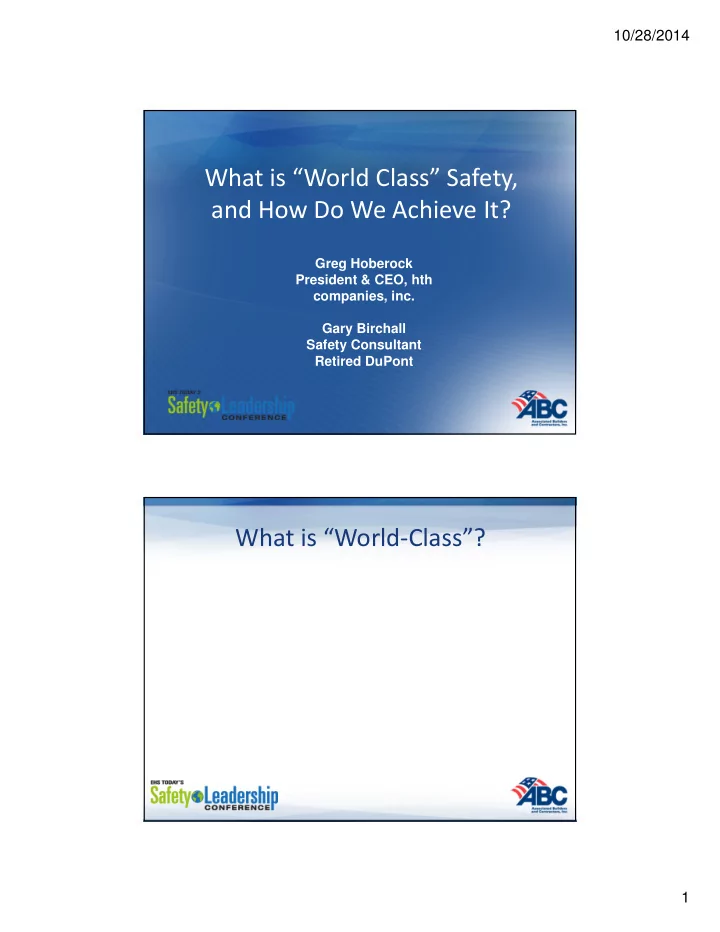

10/28/2014 What is “World Class” Safety, and How Do We Achieve It? Greg Hoberock President & CEO, hth companies, inc. Gary Birchall Safety Consultant Retired DuPont What is “World-Class”? 1
10/28/2014 The World-Class Standard for Health, Safety & Environment in the Construction Industry The world-class standard for health, safety and environment in the construction industry embodies leadership commitment to not only developing a safety culture where each person is accountable for the safety and well-being of all, but providing the means and methods for each employee to leave work in the same— or better — condition than which they arrived. Culture vs. Climate • Culture • Climate – Values – Atmosphere – Beliefs – Environment – Myths – Conditions – Traditions – Surroundings – Norms 2
10/28/2014 Safety Culture vs. Safety Climate Every company has an existing • Climate can be influenced by • internal and/or external culture (good or bad) factors • Core values determine culture • Climate can be created or changed in a very short • Culture is the foundation of period of time and can structural elements that produce results rapidly manage day to day operations • A strong culture should be • These elements are the major able to adapt to external influence of climate forces and overcome unacceptable internal issues • Culture is typically established over many years • Climate is not a replacement of culture What is Necessary for a World Class Safety Culture? Organizational Commitment & Alignment to Safety • An organizational commitment and alignment to safety can be reflected by three major components: • Safety Values • Safety Fundamentals • Clear Expections • Refers to the degree to which an organization’s upper management emphasizes safety in decision making, where execution is flawless and resources are allocated to achieve the safety vision and goals 3
10/28/2014 How do we change culture? • Change beliefs… • …to Values… • …to Core Values Progression of a Core Value • Experience & Education • “I believe safety is important” Beliefs • Beliefs to which you are willing to commit your energy Values • “Safety is one of our values” • Value that is truly internalized, habit/instinctual • “Safety is what we do; it is integrated into every Core Values facet of our operations” 4
10/28/2014 How do we change culture? Change leadership beliefs • Education: Cost, moral, business loss, ethics, legal, community pressure, news media, etc. • Experience: Taking advantage of critical events, lessons learned, industry catastrophe, etc. Change Beliefs to Values Values--beliefs that we will work on • Leadership and management alignment • Commitment workshops, deep internal dive around personal beliefs • Clear expectations • By procedure • Operational discipline • Audit, Audit 5
10/28/2014 Change Values to Core Values Core Values--values that are completely internalized • Rewarding behaviors that reflect values • Environment to invite innovation - trust and respect • Uncompromising leadership Cyclical Development of a Safety Culture Beliefs Values Climate Core (External Values Factors) Process Culture 6
10/28/2014 Leadership is Essential How does safety become a core value ? • Consistent demonstration by leadership • Senior managers should instill “safety is a core value” to all employees and align upon a SAFETY VISION • Sell the Vision by living the vision • Assign Responsibility and Accountability • Celebrate Success; learn from Failure Leadership Commitment to safety as THE Core Value – the hth Example 7
10/28/2014 What does World Class Look Like? • An aligned leadership team that manages against the highest standards, where values are not compromised • A workplace free of recognized hazards by understanding and mitigating risk to the employee and the community • Robust and efficient safety systems • A recognized leader in the industry Key Points • Leadership’s commitment are key • Beliefs become values which become core values • Leaders must live by those core values and shape the culture around those values • Cultures shape climate—both positively and negatively 8
10/28/2014 Questions? Slides will be available post- conference at www.abc.org/ehstodayslc THE JOURNEY TO SAFETY EXCELLENCE DUPONT-BRADLEY CURVE Supervision Self Team Injury Rate • Condition of • Personal • Team Natural employment commitment commitment Instincts • Discipline • Self-managing • Help others • Driven • Rules • Self-discipline conform by safety • Supervisory • Self- • Value for each • Compliance control responsibility other • Lack of • Care for self management involvement • Discipline reactive to injuries Dependent Independent Inter-dependent Reactive 18 Time 9
Recommend
More recommend